Related Research Articles
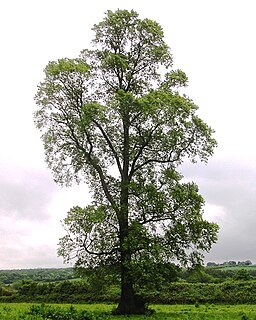
Elms are deciduous and semi-deciduous trees comprising the flowering plant genus Ulmus in the plant family Ulmaceae. The genus first appeared in the Miocene geological period about 20 million years ago, originating in what is now central Asia. These trees flourished and spread over most of the Northern Hemisphere, inhabiting the temperate and tropical-montane regions of North America and Eurasia, presently ranging southward across the Equator into Indonesia.
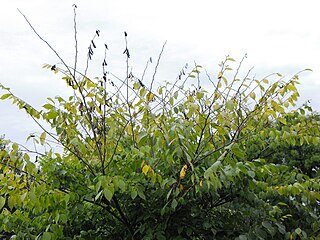
Dutch elm disease (DED) is caused by a member of the sac fungi (Ascomycota) affecting elm trees, and is spread by elm bark beetles. Although believed to be originally native to Asia, the disease was accidentally introduced into America and Europe, where it has devastated native populations of elms that did not have resistance to the disease. It has also reached New Zealand. The name "Dutch elm disease" refers to its identification in 1921 and later in the Netherlands by Dutch phytopathologists Bea Schwarz and Christine Buisman who both worked with Professor Johanna Westerdijk. The disease affects species in the genera Ulmus and Zelkova, therefore it is not specific to the Dutch elm hybrid.

Ulmus minor subsp. minor, the smooth-leaved elm, narrow-leaved elm or East Anglian elm, is a subspecies of the field elm native to southern Europe and Asia Minor including Iran.
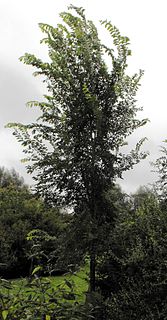
Ulmus 'San Zanobi' is a hybrid elm cultivar raised by the Istituto per la Protezione delle Piante (IPP) in Florence, from a crossing of the Dutch hybrid 'Plantyn' and the Siberian Elm Ulmus pumila clone 'S 15'; it was released to commerce in 2002. 'San Zanobi' was introduced to the UK in 2004 by Hampshire & Isle of Wight Branch, Butterfly Conservation, as part of its assessment of DED-resistant cultivars as potential hosts of the endangered White-letter Hairstreak.

Ulmus 'Plinio' is a hybrid elm cultivar derived from a crossing of the Dutch cultivar 'Plantyn' with the Siberian Elm Ulmus pumila clone 'S.2'. 'Plinio' was raised by the Istituto per la Protezione delle Piante (IPP), in Florence and released for sale in 2003. 'Plinio' was introduced to the UK in 2004 by Hampshire & Isle of Wight Branch, Butterfly Conservation, as part of its assessment of DED-resistant cultivars as potential hosts of the endangered White-letter Hairstreak.

Ulmus wallichianaPlanch., the Himalayan elm, also known as the Kashmir elm and Bhutan elm, is a mountain tree ranging from central Nuristan in Afghanistan, through northern Pakistan and northern India to western Nepal at elevations of 800–3000 m. Although dissimilar in appearance, its common name is occasionally used in error for the cherry bark elm Ulmus villosa, which is also endemic to the Kashmir, but inhabits the valleys, not the mountain slopes. The species is closely related to the wych elm U. glabra.

Ulmus davidiana var. japonica, the Japanese elm, is one of the larger and more graceful Asiatic elms, endemic to much of continental northeast Asia and Japan, where it grows in swamp forest on young alluvial soils, although much of this habitat has now been lost to intensive rice cultivation.

Ulmus 'Nanguen' is a complex fourth generation Dutch hybrid cultivar raised at the Dorschkamp Research Institute for Forestry & Landscape Planning, Wageningen. Lutèce was derived from the cross 'Plantyn' ×, an ancestry comprising four field elms, a wych elm, the curious Exeter Elm ('Exoniensis'), and a frost-resistant selection of the Himalayan elm.
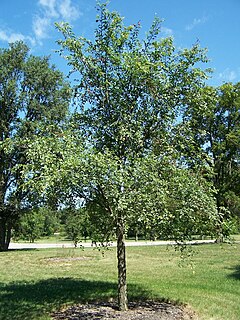
Ulmus chenmouiW. C. Cheng, commonly known as the Chenmou, or Langya Mountain elm, is a small deciduous tree from the more temperate provinces of Anhui and Jiangsu in eastern China, where it is found at elevations below 200 m on the Langya Shan and Baohua Shan mountains. The tree was unknown in the West until 1979, when seeds were sent from Beijing to the De Dorschkamp research institute at Wageningen in the Netherlands.

Ulmus szechuanicaFang, known as the Szechuan (Sichuan), or red-fruited, elm, is a small to medium deciduous Chinese tree found along the Yangtze river through the provinces of Sichuan, Jiangxi, Anhui, and Jiangsu.

Ulmus 'Lobel' is a Dutch hybrid cultivar raised at the Dorschkamp Research Institute for Forestry & Landscape Planning, Wageningen, from a crossing of clone '202' with '336'. 'Lobel' was cloned in 1962 and released for sale in 1973.
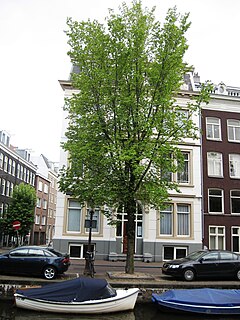
Ulmus 'Plantyn' was one of three Dutch hybrid elms released by the Dorschkamp Research Institute for Forestry & Landscape Planning, Wageningen, in 1973. Derived from a crossing of the Dutch hybrids '202' and '302', it was to prove of great significance in later developments. A selfed seedling was to become the first Dutch clone to prove effectively immune to disease, released in 1989 as 'Columella'. 'Plantyn' was also destined to be the female parent of Lutèce released in 2002. In Italy, 'Plantyn' was used again as female parent in hybridizations with the Siberian Elm Ulmus pumila by the Istituto per la Protezione delle Piante (IPP), to create three new cultivars better adapted to the Mediterranean climate.

Ulmus 'Columella' is a Dutch elm cultivar raised by the Dorschkamp Research Institute for Forestry & Landscape Planning, Wageningen, from a selfed or openly pollinated seedling of the hybrid clone 'Plantyn' sown in 1967. It was released for sale in 1989 after proving extremely resistant to Dutch elm disease following inoculation with unnaturally high doses of the pathogen, Ophiostoma novo-ulmi. However, propagated by grafting onto Wych Elm rootstocks, graft failure owing to incompatibility has become a common occurrence in the Netherlands.

Ulmus 'Exoniensis', the 'Exeter Elm', was discovered near Exeter, England, in 1826, and propagated by the Ford & Please nursery in that city. Traditionally believed to be a cultivar of the Wych Elm U. glabra, its fastigiate shape when young, upward-curving tracery, small samarae and leaves, late leaf-flush and late leaf-fall, taken with its south-west England provenance, suggest a link with the Cornish Elm, which shares these characteristics.

The Japanese Elm cultivar Ulmus davidianavar.japonica 'Jacan' is a cold-resistant selection from Canada. The tree was raised by the Morden Research Station, Morden, Manitoba in the 1980s.
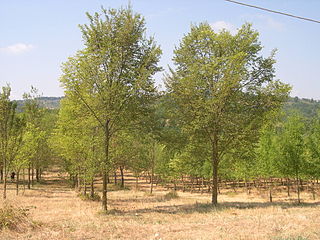
Ulmus 'Arno' is an Italian hybrid cultivar derived from a crossing of 'Plantyn' with the Siberian Elm Ulmus pumila clone S.2. It was raised by the Istituto per la Protezione delle Piante (IPP) in Florence, and released in 2007. However, 'Arno' was not a commercial success; propagation had ceased by 2010, and it is no longer patent protected.

Ulmus 'Fiorente' is a hybrid cultivar elm derived from a crossing of the Siberian Elm Ulmus pumila clone 'S.10' from Lucca, Italy, with the Ulmus minor clone 'C.02' from Lungarno, Florence, by the Istituto per la Protezione delle Piante (IPP), part of the Italian National Research Council, in Florence. 'Fiorente' was patented in 2006, and released to commerce in 2012.

Ulmus 'Morfeo' is a hybrid elm cultivar raised by the Istituto per la Protezione delle Piante (IPP), Florence, in 2000. 'Morfeo' arose from a crossing of the Dutch hybrid clone '405' and the Chenmou Elm, the latter a small tree from the provinces of Anhui and Jiangsu in eastern China, The '405' clone is a full sister of 'Groeneveld', a crossing of an English U. × hollandica and a French U. minor from the Barbier Nursery, Orléans.

Ulmus 'Wingham' is a complex hybrid elm cultivar featuring two Asiatic and two European species, bestowing it with an exceptionally high resistance to Dutch elm disease (DED). It was raised by the Istituto per la Protezione delle Piante (IPP) in Florence, but never patented owing to its limited aesthetic appeal. It was introduced to the UK in 2011 by Dr David Herling, Resistant Elms, who trialled it successfully at Wingham in Kent. It was later trialled by Hampshire & Isle of Wight Branch, Butterfly Conservation, as part of an assessment of DED-resistant cultivars as potential hosts of the endangered White-letter Hairstreak. 'Wingham' was released for sale in the UK in 2019.
References
- ↑ Santini A., Fagnani A., Ferrini F. & Mittempergher L., (2002) San Zanobi and Plinio elm trees. HortScience 37(7): 1139-1141. 2002. American Society for Horticultural Science, Alexandria, VA 22314, USA.
- ↑ Santini A., Fagnani A., Ferrini F., Mittempergher L., Brunetti M., Crivellaro A., Macchioni N. (2004). Elm breeding for DED resistance, the Italian clones and their wood properties. Archived 2007-10-26 at the Wayback Machine Invest Agrar: Sist. Recur. For. (2004) 13 (1), 179-184. 2004.
- ↑ Santini, A., Pecori, F., Pepori, A., & Brookes, A. (2011). 'Morfeo' Elm: a new variety resistant to Dutch elm disease. Forest Pathology, April 2012, Vol. 42, Issue 2, 171-176